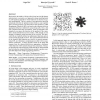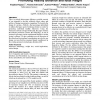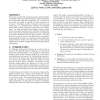611 search results - page 31 / 123 » Using GP to Model Contextual Human Behavior |
MOBIQUITOUS
2008
IEEE
14 years 2 months ago
2008
IEEE
A fundamental requirement for autonomic computing is to be able to automatically infer how human users react in similar contextual conditions. This paper examines the problem of a...
SMI
2008
IEEE
14 years 2 months ago
2008
IEEE
Motivated by the ability of living cells to form into specific shapes and structures, we present a new approach to shape modeling based on self-organizing primitives whose behavi...
CHI
2011
ACM
12 years 11 months ago
2011
ACM
This is a critical design paper offering a possible scenario of use intended to provoke reflection about values and politics of design in persuasive computing. We describe the des...
ICARCV
2006
IEEE
14 years 2 months ago
2006
IEEE
— As confirmed by recent neurophysiological studies, the use of dynamic information is extremely important for humans in visual perception of biological forms and motion. Apart ...
ATAL
2006
Springer
13 years 11 months ago
2006
Springer
We present a method for learning a human understandable, executable model of an agent's behavior using observations of its interaction with the environment. By executable we ...



